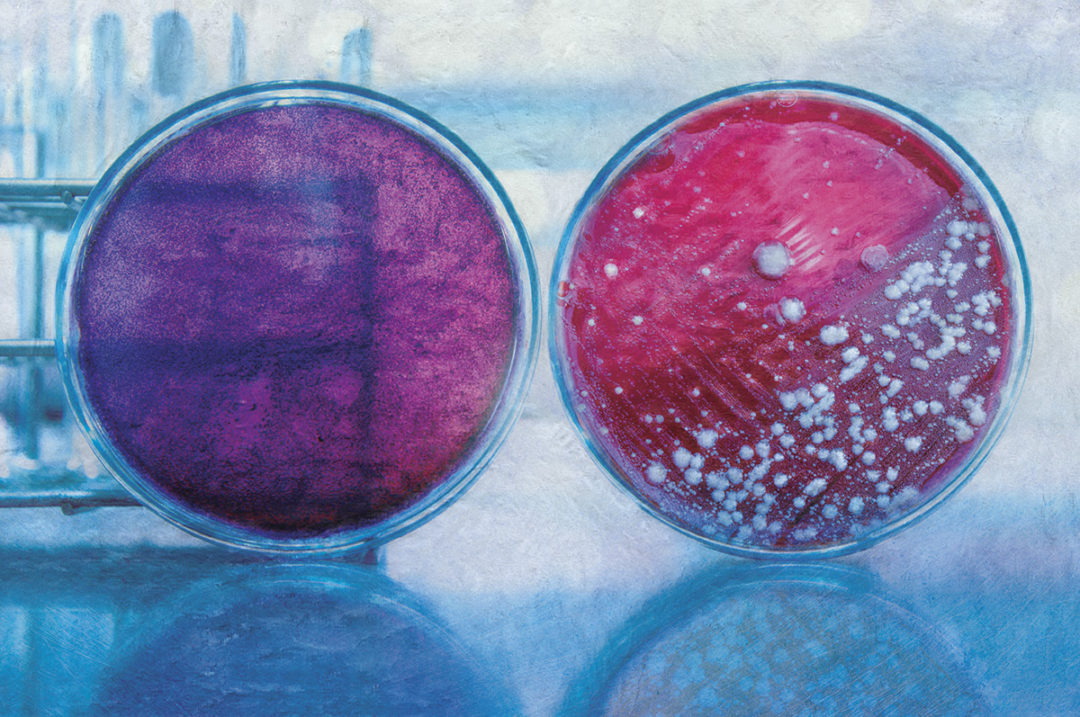Mastitis is the most common and costly disease in the dairy industry. The average cost of a case of mastitis is around $250 per case. Estimates range from less than $100 to greater than $800 per case. Ranges in mastitis cost give insight into the complexity of the disease. Milk production, treatment decisions and cow value can all have an impact on the cost. One factor that can impact all decisions made about a mastitis case is the infecting bacteria type.
Determining the infecting bacteria type allows for a more guided treatment decision. Not all producers can work with a veterinarian to culture milk samples, and results from on-farm culturing can be difficult to interpret. However, being able to at least categorize the infecting pathogen can provide valuable information. Knowing whether the infecting pathogen is gram-negative or gram-positive can provide insight into treatment decisions and lessen the economic impact of a mastitis case.
Appearances of gram-negative and gram-positive bacteria
Gram-negative and gram-positive bacteria are different in their cellular structure. Gram-negative bacteria have an outer layer of lipid membrane. Gram-positive bacteria do not.
In gram-negative bacteria, the lack of the outer membrane results in penetration and withholding of the purple crystal violet stain during the gram stain process. Therefore, gram-positive bacteria are purple when looked at under the microscope after the staining process. Gram-negative bacteria will have a pinkish or reddish color after the staining process.
Determining gram-negative vs. gram-positive bacteria
Most farms do not have a lab capable of doing gram staining. Though on-farm culturing can be difficult, selective growth medias can make culture results much easier to interpret. Bi-plates with selective medias can be used to differentiate gram-negative and gram-positive bacteria types. For example, some media will allow for the growth of gram-positive bacteria only, while others only allow for gram-negative growth. Therefore, whichever side we see bacteria growth on indicates the bacteria type. Knowing whether the bacteria is gram-positive or gram-negative can help make a more educated treatment decision.
Common bacteria types
Gram-negative bacteria inhabit soils and the intestinal tract of animals. Coliform pathogens such as E. coli and Klebsiella are the most common gram-negative mastitis-causing pathogens.
Gram-positive bacteria are a part of the body’s normal flora and can be found on the skin, mucus in the mouth and the digestive system. Though commonly found on the body, they can cause infections when they enter the body and rapidly multiply. Any staphylococcus and streptococcus species are gram-positive.
Both gram-negative and gram-positive bacteria are found in the environment. Most bacteria types of both cell types would be considered “environmental mastitis” pathogens. Gram-positive bacteria like Staph aureus, Strep agalactiae and mycoplasma are contagious pathogens.
Differences in mastitis severity
The severity of mastitis cases is highly dependent on the specific pathogen. However, some trends between gram-negative and gram-positive bacteria exist. Only about half of strep infections will result in clinical cases, while up to 80% of coliform infections (gram-negative bacteria) result in clinical mastitis. Approximately 70% of environmental pathogen infections will last shorter than 30 days. Fifty percent of coliform infections will last no greater than 10 days.
Though coliform infections tend not to last as long, they can be more severe. About 10% of coliform infections will result in infections that require intensive therapy and veterinary care. Unlike gram-positives, gram-negatives produce an endotoxin. Once the outer membrane of the cell is broken, endotoxins can enter the bloodstream and cause a systemic infection. Systemic infections will cause other clinical disease signs. Many of these severe infections will significantly impact lactation milk yield and may lead to the cow's death.
Some studies have also found that gram-negative infections can have a more significant effect on reproductive performance. A gram-negative infection within a week after breeding can drop conception rates by 80%.
Making treatment decisions
Antibiotics have a hard time penetrating the outer layer of the cell wall in gram-negative bacteria. Therefore, intramammary antibiotic treatment of gram-negative bacteria is not very successful and is often not recommended. In severe coliform cases where cows are systemic, the system infection (not the mammary infection) should be treated.
Label recommendations for strep and non-Staph aureus have proven to be successful. Treatment success and recommendations are herd-specific. Dairy farmers should work with their veterinarians to develop treatment procedures for mastitis cases in their herd.
Preventing and tracking mastitis cases
Whether dealing with gram-negative or gram-positive bacteria, both can be prevented by reducing the cows’ exposure to bacteria. Reduction in exposure can be accomplished by providing a clean and dry environment and focusing on proper procedures in the parlor. Most farms have a common mastitis pathogen or a small number of different pathogens that impact the herd. Changes in prominent pathogen types can be an indication of changes in pathogen populations and therefore can indicate whether the focuses of mastitis management need to be adjusted.






